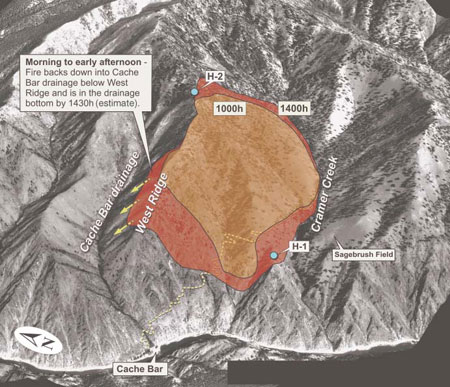
Lessons Learned
“Safety
Zone” newsletter, July, 2004
Lessons Learned —
author, date unknown
One-Year Anniversary Letter
by Kelly Close, FBAN
Declaration on Cramer
Redactions, by James Furnish, April, 2005
FSEEE v. USFS, FOIA
Civil Lawsuit Order,
December, 2005
FOIA
Request to USFS, December, 2005
FOIA Appeal to USFS,
February, 2006
Management Evaluation Report
Investigation Team Information
Synopsis of the
Cramer Fire Accident Investigation
Causal Factors
Contributing Factors
Addendum
Factual Report
Executive Summary
Narrative
Background
(facts 1 - 57)
Preaccident
(facts 58 - 201)
Accident
(fact 202)
Postaccident
(facts 203 - 237)
Findings
Appendix A
Resources on the Fire
Appendix B
Cramer Fire Timeline
Appendix C
Fire Behavior and Weather
Prior Conditions
Initial Phase
Transition
Phase
Acceleration
Phase
Entrapment
Phase
Appendix D
Equipment Found at H-2 and the Fatalities Site
Appendix E
Fire Policy, Directives, and Guides
OIG Investigation
OIG FOIA Response,
February, 2005
2nd FOIA Request to OIG,
April, 2006
2nd OIG FOIA Response,
August, 2006, (1.4 mb, Adobe .pdf file)
OSHA Investigation
OSHA Cramer Fire Briefing Paper
• Summary and ToC
• Sections I-IV
• Sections V-VII
• Section VIII
• Acronyms/Glossary
OSHA South Canyon Fire
Briefing Paper
Letter to District
Ranger, June 19, 2003
OSHA Investigation Guidelines
OSHA News Release
• OSHA Citation 1
• OSHA Citation
2
• OSHA
Citation 3
USFS Response
OSHA FOIA Letter
Adobe PDF and Microsoft Word versions of documents related to
the Cramer Fire can be downloaded from the U.S.
Forest Service website.
|
Accident Investigation
Factual Report
Cramer Fire Fatalities
North Fork Ranger District
Salmon-Challis National Forest
Region 4
Salmon, Idaho - July 22, 2003
Appendix C—Fire Behavior and Weather
Acceleration Phase, July 22 (1400 to 1500)
Between 1330 and 1400, the fire was making small runs in the grass with
upcanyon winds and backing downslope into the main Cramer Creek drainage
with low flame lengths. H-1 was being pressed by fire.
By 1400, the shortwave disturbance had started to move into central Idaho.
This brought increased windspeeds and a strong flow from the northwest
that began to overpower local diurnal winds. Fire activity began to increase
dramatically over the entire fire, as well as on other fires in the area.
Winds were reported as “whipping back and forth,” and a large
brown smoke column formed west of H- 1. The fire burned with increasing
intensity, moving east and downslope with stronger winds, overrunning
H-1. To the west, fire continued to back down below the West Ridge into
the Cache Bar drainage.
With hot conditions, increasing winds, and dried, preheated foliage from
the backing fire, the smokes began to transition to an active fire front
between 1430 and 1440. The general winds were overcoming local diurnal
winds in the canyon. Although the ridgeline between Fountain Creek and
the Cache Bar drainage sheltered the bottom of the drainage from the northwesterly
winds initially, the shift to a more westerly flow aligned with the eastwest
orientation of the Cache Bar drainage, and overall updrainage windspeeds
began to increase. The fire in the Cache Bar drainage was building simultaneously
to the fire buildup in Cramer Creek. See figure 23 for estimated perimeter
growth and figure 24 for estimated backing spread into the Cache Bar drainage.

Figure 23—Cramer
Fire perimeter and spread on July 22, 2003, by 1430 (estimate).

0830–0850: Smokes seen
below West Ridge.

1300: Smokes and backing fire
seen
down to midslope below West Ridge.

1430: Fire estimated to have
backed
down to lower portion of drainage.
Figure 24—Fire spread estimates from backing and rollouts
into the Cache Bar drainage.
<<<
continue reading Appendix C, Entrapment Phase >>>
|
